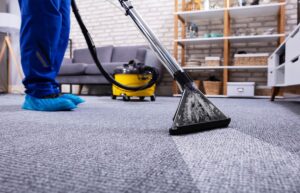What Products and Techniques to Avoid When Cleaning a Microwave?
6 min read
When it comes to cleaning a microwave, there are certain products and techniques that should be avoided to prevent damage and ensure safety.
That’s why it’s so crucial to use proper cleaning materials and adhere to certain standards and guidelines when you want to leave your appliance spotless.
Read on to learn the do’s and don’ts of microwave cleaning.
What you must never do when cleaning your microwave
Making some of the mistakes below can render your appliance useless and even be hazardous to your health. That’s why it’s best to avoid these actions altogether.
Here is what to avoid doing when cleaning your microwave:
- Abrasive cleaners. Abrasive cleaners, like steel wool pads and scouring powders, can scratch the interior surfaces of the microwave, making it more difficult to clean in the future. Scratches can also create the ideal environment for bacteria to breed.
- Harsh chemicals. Harsh chemicals, such as bleach, ammonia, or strong solvents, can release fumes when they’re heated, which can be hazardous and contaminate your food. Instead, stick to milder, food-safe cleaning agents.
- Excessive water or liquid. While using water or liquid is generally safe for cleaning a microwave, avoid excessive amounts because they can seep into the internal components and cause damage to the appliance. Use a damp cloth or sponge instead of soaking the interior.
- Unapproved cleaning products. Before cleaning your microwave, it’s essential to read the manufacturer’s instructions and use cleaning products specifically recommended for cleaning it. Using unapproved cleaning products can damage the interior coating or other sensitive parts of the appliance.
- Clorox or Lysol wipes. Cleaning a microwave with Clorox or Lysol wipes should also be avoided because these products contain chemicals that can damage the appliance.
- Foil or metal. Using foil or metal objects to clean the microwave is very likely going to cause damage to the appliance by scratching its key elements or its protection. They also pose the risk of the microwave catching on fire.
- Air fresheners. Household air fresheners shouldn’t be used to get rid of unpleasant smells in the microwave under any circumstances. They can leave behind a residue that will spread around the appliance when it’s used, and the chemicals will contaminate your food.
- Turning the microwave while there are chemical cleaners inside. If your microwave is turned on while there are chemicals in it, these compounds can result in adverse reactions, which can permanently damage your appliance, erode its metal parts, set a fire and create smoke or unpleasant smells. This will make your microwave unusable.
What are the proper ways to clean your microwave?
Now that you know what you must never do when you are cleaning your electrical appliance, let’s take a look at what are the most effective ways to do so properly.
Some safe and effective techniques for cleaning a microwave to use instead include:
Vinegar and water solution
Mix equal parts of H2O and distilled white vinegar in a microwave-safe container. Place it in the microwave and heat it on the highest setting for a few minutes until the mixture boils and starts steaming. The steam will help loosen any food splatters and stains. After that, carefully remove the container and wipe the inside surfaces using a damp cloth or sponge.
Baking soda paste
Create it by mixing baking soda with H2O until it forms a thick consistency. Apply it to stubborn stains or dried-on food particles inside the microwave and let it sit for a few minutes, then gently scrub with a non-abrasive sponge or cloth. Afterwards, rinse it thoroughly with water.
Lemon or citrus
Squeeze the juice of a lemon or other citrus fruit into a microwave-safe container filled with water. Place the bowl in the microwave and heat it on the highest setting for a couple of minutes. The steam created will help loosen any grime and eliminate unpleasant odours. Afterwards, carefully remove the bowl and wipe down the interior with a damp cloth.
Regular maintenance
To prevent excessive buildup, cover food containers with microwave-safe lids or use microwave-safe covers when heating food. Always wipe spills or splatters as soon as they appear with a damp cloth or sponge to prevent them from hardening and becoming more difficult to clean. As an additional safety precaution, always unplug the microwave before cleaning and be very careful when handling hot surfaces or liquids.
Parts of the microwave that people often forget to clean
There are a few parts of the microwave that people often forget to clean because these areas may not be as obvious.
However, regularly cleaning these components is still important for maintaining a clean and hygienic microwave.
Some commonly overlooked ones include:
The ceiling and walls
The ceiling and walls of the microwave can accumulate food splatters and steam residue over time. It’s important to wipe them down regularly to prevent the buildup of grease, grime, and odours, which will harden over time and become more challenging to clean. Regularly use a damp cloth or sponge to wipe the interior surfaces, paying special attention to the areas near the vents.
The door and handle
The microwave door and handle are frequently touched but often neglected during cleaning. These areas should also be cleaned regularly using a mild detergent or a solution of vinegar and water. Wipe them thoroughly, removing any fingerprints, stains, or food residue and don’t forget both the exterior and interior surfaces of the door.
Turntable and support ring
The turntable and support ring are removable components in most microwaves, which can also accumulate food debris and spills. Remove them from the microwave, wash them with warm, soapy water, rinse them thoroughly and wipe them dry before placing them back in the microwave.
The air vents and filters
The air vents and filters in a microwave are necessary for proper air circulation and for preventing the buildup of excess moisture. Over time, they can also accumulate grease and dust. To clean the vents, use a soft brush or vacuum cleaner with a brush attachment. As a safety precaution, consult your microwave’s manual for instructions on how to clean or replace the filters, as it may vary depending on the model. Besides that, if the air filters are left uncleaned for long enough, they will collect grease, which won’t only affect the performance of the appliance but also pose a fire hazard.
Control panel and buttons
The control panel and buttons are frequently touched parts, which can lead to the accumulation of fingerprints, oils, and dirt. Use a soft, damp cloth or a mild cleaning solution to wipe them and avoid using excessive water or liquid to prevent damage to the electronic components.
Are there parts of the microwave that shouldn’t be touched ever?
Much like when you’re cleaning your oven, there are certain parts of the microwave that shouldn’t be touched because they can pose a risk of electric shock or damage to the microwave if they’re mishandled.
The parts that should be avoided include:
High-voltage components
The high-voltage components of a microwave, such as the magnetron and capacitor, carry high electrical currents and can cause severe electric shocks. It’s best to leave any repairs or maintenance involving them to a qualified professional.
The electrical connections
Avoid touching any exposed electrical connections within the microwave. Tampering with them can lead to electric shock or damage to the appliance. If you suspect any electrical issues, it’s recommended to contact a qualified technician for assistance.
Sealed compartments
Microwaves have sealed compartments, such as the cavity where food is heated, to contain and direct microwave energy. These compartments shouldn’t be opened or tampered with by unqualified individuals because they can expose you to harmful microwaves and may also damage the appliance.
Cooling fan and ventilation openings
The cooling fan and ventilation openings are important for dissipating heat from the microwave during its operation. While they may appear accessible, it’s recommended not to touch or block them. Doing that can lead to overheating and affect the performance and safety of the microwave.
Conclusion
So, these are pretty much the do’s and don’ts of cleaning your microwave. Now that you know how to do that chore safely and efficiently, you can easily accomplish the task.
However, if it seems too daunting, you can always take advantage of qualified oven cleaners who will take care of all the work for you.







